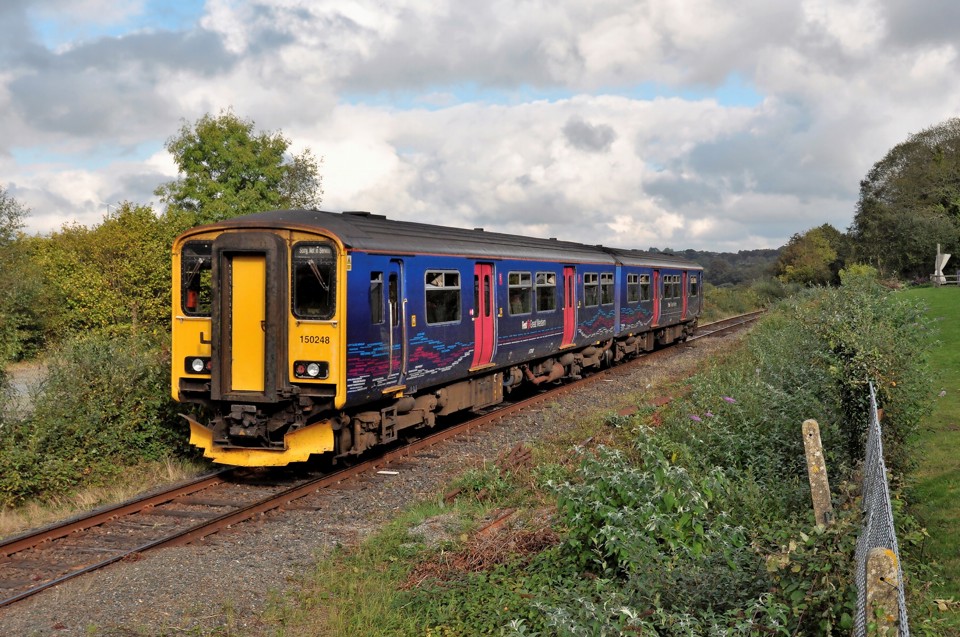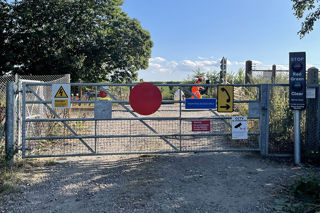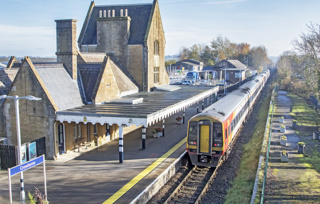- This feature was originally published in RAIL 871.
When the Dawlish Sea Wall was breached five years ago, the damage was made good by an extraordinary (“Herculean”, according to David Cameron) effort.
But for two months, Plymouth, Torbay and Cornwall had no train services to the rest of the country. With widespread media coverage, tourism chiefs had to reassure the public that the West Country was “still open for business”.
Fast forward five years, and Cornwall/south Devon is still in need of reassurance. It has become clear that while the February 2014 breach was dramatic, further similar events are unavoidable. Indeed, as Professor Jon Shaw of Plymouth University along with colleagues Dawson and Gehrels at Leeds and York Universities have shown, the problem is one of rising sea levels compounded by more extreme weather events.
Their published work shows that the rate of sea level rise has been higher since the mid-1970s, and that this is set to continue - driven by higher global levels of carbon emissions. The consequences for the railway at Dawlish are that full line closures can be expected to increase from the current rate of one every other year to (on average) once every year by 2040, and by 2100 three times per year. By this stage, on average, on three days per week speed limits will be in place affecting rail operations on the line through Dawlish.
Climate change is also increasing the risk of landslip from the steep cliffs between Teignmouth and Parsons Tunnel, which would block the main Exeter-Plymouth railway line. Such a landslip happened in 2014 within days of the track being cut by waves nearby at Dawlish.
Network Rail has identified two remedial options. The first involves cutting back the sea cliffs to a 30° slope. The second would relocate the line further out to sea, allowing room to stabilise the base of the cliffs. On a longer-term timescale, rockfall shelters to protect the railway and trains from any falling debris to the east of Parsons Tunnel will also be needed.
Network Rail also believes that action is needed to protect the railway along the Exe and Teign estuaries, where responsibility lies with the Environment Agency.
Over the next 15 to 30 years, the embankments along these estuaries will have to be raised and drainage improved.
While studies of the Dawlish/Teignmouth problem are under way, funded by Network Rail (£10 million in 2016), the funds needed for the remedial measures themselves (which will carry costs likely to be in the £0.5bn-£1bn range) have not yet been committed.
So, this much is clear: while nobody proposes to abandon the line via Dawlish, the costs of keeping it in place are high. Even then, services will be periodically cut. And on many more occasions, journey times will be extended with speed restrictions applied.
The need for resilience
A year ago, then-Rail Minister Jo Johnson said that there was no “miracle cure” for Dawlish. But when Storm Emma in March 2018 led to homes in Dawlish being evacuated, with part of the rail line damaged again and a seaside cafe washed away, ministers renewed their pledge to do “whatever it takes” to safeguard the Dawlish rail line.
It is in this context that politicians are coming round to the idea that more needs to be done to ensure the resilience of the South West’s rail services.
In September 2017, Labour Party leader Jeremy Corbyn promised that if his party wins power, it would allocate £600m for rail resilience work at Dawlish and have an all-weather bypass route in the future. Two months later, Transport Minister Jesse Norman said that reopening a railway line avoiding the coast, via Okehampton and Tavistock, was a “very important potential idea” and that it would be in addition to the Dawlish line.
Network Rail had estimated the cost of such a scheme around the north side of Dartmoor at £875m in 2014, significantly less than the inland tunnelled options examined for a possible Exeter-Newton Abbot cut-off (which were costed at up to £3bn). But according to Network Rail’s assessments, none of these options has a good business case.
Of course, projects designed to ensure basic network resilience may suffer in business case appraisals that use tools shaped for examining service enhancements. The methodology to assess the value of keeping a line open through the year - even when it is a main line with significant passenger volumes - is little understood.
Yet other countries have found it makes sense to undertake major investments, rather than wait for sea level rises that damage rail infrastructure. A good example is the Mediterranean coastal line in Italy between Genoa and Ventimiglia, which has recently been replaced with a largely tunnelled inland route.
It is surely time to progress the creation of a second railway across Devon - an Exeter-Plymouth line around the north side of Dartmoor.
Clarity of purpose
A key issue affecting rail reopening or new line schemes is getting clarity of purpose at the outset.
The Borders Railway is a success and its objectives were clear: the aim was better connectivity, to link the otherwise remote Border towns with the thriving city of Edinburgh. Even so, the basic infrastructure specification that allows two trains per hour and a journey time of under an hour has not gone unchallenged, because it limits future train service options.
Take a more complex line such as Oxford-Cambridge, and the number of service options is huge (to/from Milton Keynes or direct services from Oxford-Bedford; multiple stops/semi-fast, services to/from Aylesbury, or extensions of services onwards from Oxford to Reading, or even Heathrow).
Likewise, there is the range of possible primary objectives: to support housing growth; to allow more sustainable commuting to the cities the line serves; to provide better regional and/or inter-regional connectivity; to provide more direct routes for rail freight to/from Southampton and/or Felixstowe (when the eastern section is opened). Lack of clarity on objectives leads to costly infrastructure and/or less benefit.
Recent examinations of the case for the Exeter-Okehampton-Tavistock-Plymouth line have reflected differing policy purposes.
A 2014 Network Rail assessment assumed line reconstruction to allow up to 125mph running, and also presumed that parts of the existing line between Exeter St Davids and Yeoford would need to be realigned at a higher elevation to avoid future flood risk. Yet Plymouth-Exeter journey times would still not quite match those via Newton Abbot. Another assumption - service provision with a dedicated train fleet - also meant high operating costs.
In contrast, a study by Jacobs for Devon County Council in 2016 adopted a train service specification provided with no fewer than 15 intermediate station calls (and again a dedicated train fleet). So, unsurprisingly, with a journey time of two hours between Exeter Central and Plymouth, and with most journeys still quicker by bus, demand projections (and thus benefits) were low with operating costs remaining stubbornly high.
Therefore, the first requirement is to be clear about the objectives with all stakeholders. This route would not even be considered were it not for the function that it can fulfil as an alternative to the route via Dawlish. It is the prospect of continuing disruption that the existing main line faces, and the consequent long-term damage to the South West’s economy, that drives the need for the second line - and its specification must surely reflect that fact.
Objective #1 is to provide network resilience, and that means that the line needs to offer journey times for Cornwall/Plymouth services to the rest of the country similar to those achieved via Dawlish.
Meeting local social and economic needs
Establishing the value of having a resilient network with dependable year-round services for the South West is therefore a key part of the equation. But there is much more besides to feed into the business case.
Greengauge 21 examined the case for reopening the Exeter-Okehampton-Tavistock-Plymouth line in a report published in June 2015 (Rural reconnections: the social benefits of rail reopening Exeter-Okehampton-Tavistock-Plymouth, a case study - available at www.greengauge21.net).
The project was supported by Network Rail and funded by the Campaign to Protect Rural England (CPRE), and focused on this question: could this line serve the large rural hinterland of mid-Devon, west Devon and north east Cornwall, helping to reduce reliance on car use and to foster sustainable development? The research examined the local economic and social impacts of reopening the line, and how the overall business case could be improved.
Meeting Objective #1 means that intermediate station calls need to be minimised. And this fits well with local planning policies that seek to concentrate development (starting with a 10% increase in housing stock) in Tavistock and Okehampton, where other amenities can be provided cost-effectively. By serving Okehampton and Tavistock en route, the line would also help fulfil local planning and development aspirations.
In a conventional transport economic appraisal, land use is assumed to be the same in the ‘do-something’ and ‘do-nothing’ cases. But the populations of Tavistock and Okehampton will each be higher if the railway service is opened. Research with Tavistock residents shows that the wider public is well aware of this linkage. Project appraisal must take this factor into account.
The line serves a hinterland that is one of the least accessible parts of England, furthest from a railway station, and with low pay levels and poor work opportunities.
This is a region, we discovered, where access to higher education is a major challenge. The main highway network does not deliver congestion-free access to the cities of Exeter and Plymouth. Journey times to college and to the major employment centres are lengthy and unreliable. For young people, one choice may be leaving home, but this reinforces the trend of rural depopulation and results in growing age and skills imbalances.
Rail services direct to city centres offer a way to change this trend. They would also expand the labour force and market catchment areas of Devon’s two major cities.
Improving regional connectivity
At a time when other regions will become better connected with London, the South West (as a minimum) needs to protect its existing journey times.
With just two intermediate stops (Okehampton and Tavistock), timings should be very similar to those achieved via Newton Abbot. And a cut-off to the north of Cowley Bridge Junction would save 5-10 minutes running time and 3-5 minutes turn-round time at Exeter St Davids, meaning that journey times could be shorter than today’s from Cornwall and Plymouth to Bristol and beyond and to London.
With higher service frequencies as planned for the main lines to London and Bristol in the medium/longer term, it would make sense to split the service plan, with some operating (as now) with station calls at Newton Abbot and Totnes, and others taking the northern route (which could be the faster option if the station call at Exeter St Davids is omitted).
The line offers a more easily-graded route for rail freight. This could obviate the need for the current practice of splitting freight trains in two over the South Devon banks section. It also provides a diversionary route for freight, ensuring continuity of service.
A compelling case for investment
To the primary need for resilience in the rail network serving the South West, the Greengauge 21 Rural Reconnections research in 2015 adds the local and regional case: “A new line could go some way to addressing the impediments to local business and tourism caused by the absence of a rail service, as well as providing a chance to maintain the sustainability and vibrancy of existing communities through supporting the provision of new housing that includes provision for affordable homes.
“A new line has the support of Devon County Council, which has been pursuing a scheme to reopen the line northwards as far as Tavistock for some time. And, crucially, it also has the strong support of local people. The communities that would be served by a reopened railway in west Devon are generally very positive about it. As communities in west Devon and north Cornwall are currently far from railheads, it would particularly benefit journeys to work, journeys for education and training, and business travel.”
The creation of a through route, rather than a pair of branch lines, will be crucial to attract the capital funding needed. Avoiding stub-end branches improves service economics and allows Network Rail to offer rail service diversions when needed - as will be the case even with the remedial works that are needed at Dawlish/Teignmouth have been implemented.


















Login to comment
Comments
No comments have been made yet.